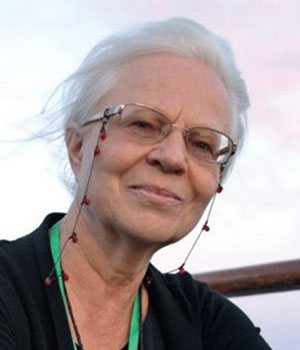
Olga Kocharovskaya, distinguished professor of physics and astronomy at Texas A&M University, has been selected to receive the American Physical Society's 2023 Norman F. Ramsey Prize in Atomic, Molecular and Optical Physics, and in Precision Tests of Fundamental Laws and Symmetries.
Established in 2017 and named for 1989 Nobel Prize in Physics recipient Norman Foster Ramsey, the Ramsey Prize is awarded annually to recognize outstanding work in precision measurements of fundamental constants and tests of fundamental laws and symmetries or in atomic, molecular and optical physics.
Kocharovskaya, who is recognized as one of the top quantum optics and laser physics researchers worldwide, joined the Texas A&M Department of Physics and Astronomy faculty in 1998 after 12 years as the leading research scientist at the Institute of Applied Physics of the Russian Academy of Sciences. She was appointed as a distinguished professor in 2007 and is a member of the Institute for Quantum Science and Engineering.
Kocharovskaya is cited by the Ramsey Prize selection committee "for pioneering work in quantum coherence and x-ray quantum optics." She will be presented with her $10,000 check and accompanying certificate at the 54th Annual Meeting of the APS Division of Atomic, Molecular and Optical Physics (DAMOP), set for June 5-9 in Spokane, Washington.
Kocharovskaya received her Ph.D. from the N.N. Lobachevsky Nizhny Novgorod State University in Russia in 1986 as well as a Dr. of Sciences (Habilitation) degree from the Highest Attestation Commission of the Russian Federation in 1996. Her research is in the areas of quantum and nonlinear optics, laser physics, x-ray optics, attosecond physics and quantum information science.
Throughout her career, Kocharovskaya has made major contributions to the rapidly developing field of atomic coherence phenomena, including pioneering works on lasing without inversion, electromagnetically induced transparency, "stopped light" and shaping the waveforms of the single gamma photons via their resonant interaction with the nuclear ensembles. She has authored or co-authored more than 200 scientific papers. Her most recent work is focused on coherent control of the optical electronic and gamma-ray nuclear transitions in solids.
A fellow of both the American Physical Society and Optica (formerly known as The Optical Society of America), Kocharovskaya's previous recognitions include the inaugural Willis Lamb Medal for Laser Physics and Quantum Electronics, the Presidential Award of the Russian Academy of Sciences as the Outstanding Young Professor of the Russian Federation, the Texas A&M Association of Former Students Distinguished Achievement Award in Research and the Sigma Xi Distinguished Scientist Award
Jointly administered by the APS Topical Group on Precision Measurement and Fundamental Constants and the APS DAMOP, the Ramsey Prize is funded by contributions from the family and friends of Norman Ramsey, individual donations from APS members, corporate sponsorship by TOPTICA and Thorlabs, and additional support from Menlo Systems. Previous recipients include Harvard University physicist and 1998 Texas A&M physics Ph.D. graduate Mikhail Lukin (2022).
